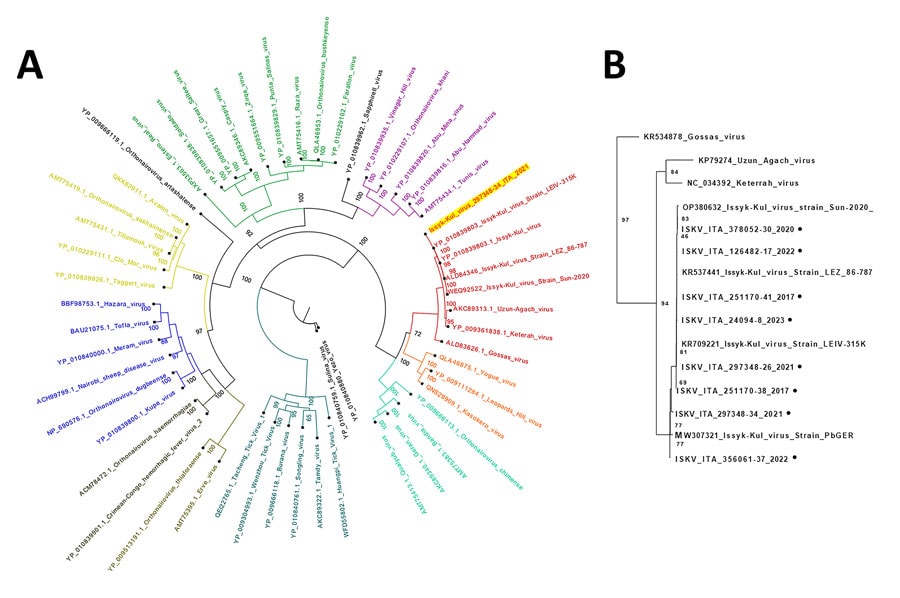Volume 30, Number 4—April 2024
Dispatch
Isolation of Batborne Neglected Zoonotic Agent Issyk-Kul Virus, Italy
Figure 2

Figure 2. Phylogenetic analysis of isolates from study of batborne neglected zoonotic agent Issyk-Kul virus, Italy A) Phylogeneny nairovirus protein sequences for Orthonairovirus large (L) segments, including the complete sequence obtained from Hypsugo savii bats, highlighted in yellow. Sequence colors were based on the genogroups proposed by Ozeki et al. 2022 (12). B) Nucleotide alignment magnification of a short PCR-targeted region of the L segment, encompassing all sequences derived from bat surveillance conducted during 2017–2023 identified as Issyk-Kul virus IT-297348-34/2022. Numbers along branches indicate bootstrap values.
References
- Lvov DK, Karas FR, Timofeev EM, Tsyrkin YM, Vargina SG, Veselovskaya OV, et al. “Issyk-Kul” virus, a new arbovirus isolated from bats and Argas (Carios) vespertilionis (Latr., 1802) in the Kirghiz S.S.R. Brief report. Arch Gesamte Virusforsch. 1973;42:207–9. DOIPubMedGoogle Scholar
- L’vov DK, Kostiukov MA, Daniiarov OA, Tukhtaev TM, Sherikov BK. [Outbreak of arbovirus infection in the Tadzhik SSR due to the Issyk-Kul virus (Issyk-Kul fever)] [in Russian]. Vopr Virusol. 1984;29:89–92.PubMedGoogle Scholar
- Atkinson B, Marston DA, Ellis RJ, Fooks AR, Hewson R. Complete genomic sequence of Issyk-Kul virus. Genome Announc. 2015;3:e00662–00715. DOIPubMedGoogle Scholar
- Brinkmann A, Kohl C, Radonić A, Dabrowski PW, Mühldorfer K, Nitsche A, et al. First detection of bat-borne Issyk-Kul virus in Europe. Sci Rep. 2020;10:22384. DOIPubMedGoogle Scholar
- Vargina SG, Kuchuk LA, Gershtein VI, Karas FR. Transmission of Issyk Kul virus by Argas vespertilionis ticks in experiment [in Russian]. Sborn nauch Tr Inst Virus Im Ivanov Akad Med Nauk SSSR. 1982;123–7.
- Bulychev VP, Alekseev AN, Kostiukov MA, Gordeeva ZE, L’vov DK. [Issyk-Kul virus transmission by Aedes caspius caspius Pall. mosquitoes via experimental bite] [in Russian]. Med Parazitol (Mosk). 1979;48:53–6.PubMedGoogle Scholar
- Kostiukov MA, Bulychev VP, Lapina TF. [Experimental infection of Aedes caspius caspius Pall. mosquitoes on dwarf bats, Vespertilio pipistrellus, infected with the Issyk-Kul virus and its subsequent transmission to susceptible animals] [in Russian]. Med Parazitol (Mosk). 1982;51:78–9.PubMedGoogle Scholar
- Cholleti H, de Jong J, Blomström AL, Berg M. Investigation of the virome and characterization of Issyk-Kul virus from Swedish Myotis brandtii bats. Pathogens. 2022;12:12. DOIPubMedGoogle Scholar
- Gigante CM, Dettinger L, Powell JW, Seiders M, Condori REC, Griesser R, et al. Multi-site evaluation of the LN34 pan-lyssavirus real-time RT-PCR assay for post-mortem rabies diagnostics. PLoS One. 2018;13:
e0197074 . DOIPubMedGoogle Scholar - Lelli D, Prosperi A, Moreno A, Chiapponi C, Gibellini AM, De Benedictis P, et al. Isolation of a novel Rhabdovirus from an insectivorous bat (Pipistrellus kuhlii) in Italy. Virol J. 2018;15:37. DOIPubMedGoogle Scholar
- Walker PJ, Widen SG, Wood TG, Guzman H, Tesh RB, Vasilakis N. A global genomic characterization of nairoviruses identifies nine discrete genogroups with distinctive structural characteristics and host-vector associations. Am J Trop Med Hyg. 2016;94:1107–22. DOIPubMedGoogle Scholar
- Ozeki T, Abe H, Ushijima Y, Nze-Nkogue C, Akomo-Okoue EF, Ella GWE, et al. Identification of novel orthonairoviruses from rodents and shrews in Gabon, Central Africa. J Gen Virol. 2022;103:103. DOIPubMedGoogle Scholar
- Lv X, Liu Z, Li L, Xu W, Yuan Y, Liang X, et al. Yezo virus infection in tick-bitten patient and ticks, northeastern China. Emerg Infect Dis. 2023;29:797–800. DOIPubMedGoogle Scholar
- Shayan S, Bokaean M, Shahrivar MR, Chinikar S. Crimean-Congo hemorrhagic fever. Lab Med. 2015;46:180–9. DOIPubMedGoogle Scholar
- Sugimoto S, Suda Y, Nagata N, Fukushi S, Yoshikawa T, Kurosu T, et al. Characterization of Keterah orthonairovirus and evaluation of therapeutic candidates against Keterah orthonairovirus infectious disease. Ticks Tick Borne Dis. 2022;13:
101834 . DOIPubMedGoogle Scholar
Page created: March 01, 2024
Page updated: March 20, 2024
Page reviewed: March 20, 2024
The conclusions, findings, and opinions expressed by authors contributing to this journal do not necessarily reflect the official position of the U.S. Department of Health and Human Services, the Public Health Service, the Centers for Disease Control and Prevention, or the authors' affiliated institutions. Use of trade names is for identification only and does not imply endorsement by any of the groups named above.